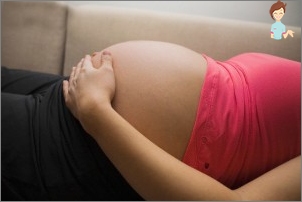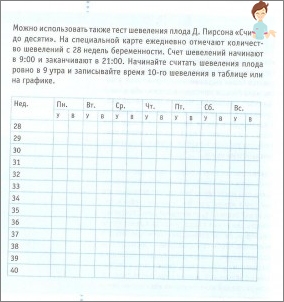Counting fetal movements – Methods of Cardiff, Pearson, Sadovsky
How to consider the chapels of the child during pregnancy? Methods: Cardiff, Pearson, Sadovsky and others. Women’s reviews.
The first movement of the child during pregnancy is the most important moment in the life of the future mother, which is always expected to be impatient. After all, while your baby in the womb, the movement is his peculiar language, which will tell mom and doctor, whether everything is in order with the crumb.
Fetal movements – when?

Usually, a woman begins to feel the first movements after the twentieth week, if it is the first pregnancy, and at the eighteenth week at the following.
True, these deadlines may vary depending on:
- nervous system of the woman itself,
- From the sensitivity of the future mother,
- from the weight of pregnant (more complete women begin to feel the first movements later, thin – somewhat earlier than the twentieth week).
Of course, the kid moves around from the eighth week, but while he has enough space, and only when it increases so much that it can no longer contact the walls of the uterus, mother begins to feel.
The activity of the kid depends on many factors:
- Timesand day – as a rule, the baby is more active at night
- Physical Loads – When the mother leads an active lifestyle, the movements of the baby are usually not felt or is quite rare
- From nutrition Future mom
- Psychological state pregnant woman,
- from others Sounds.
An important factor influencing the chapels of the child is his character – from nature there are movable and low-effective people, and all these features appear already during intrauterine development.
About twenty-eighth weeks The doctor can offer a future mother to follow the movements of the fetus and count them according to a certain scheme. It is believed that this technique is used only when it is not possible to conduct a special examination, such as KTG or Doppler, but it is not.
Now increasingly in the map of the pregnant woman includes a special table that will help the future mom to celebrate her counts.
We consider movements: why and how?
The opinions of gynecologists about the need to keep a diary of the child’s chapels diverge. Someone believes that there are enough modern research methods, such as ultrasound and ktg, to identify the presence of problems, it is easier to pass them than to explain to the woman what and how to count.
In fact, the survey conducted by one-time shows the condition of the baby at the moment, but the changes can occur at any time, so the future mother is usually at the doctor’s reception asks questions about whether it did not notice any changes in shelling. Such changes may be a reason for sending a re-examination.
Of course, you can follow this without calculations and recordings. But maintaining a diary, no matter how boring things it does not seem to be pregnant, will help her much more accurately determine how her child is developed.
Why do you need to monitor the mines of the kid so carefully?
First of all, the counting of movements helps in time to understand that the child feels discomfort, conduct a survey and take the necessary measures. Future mom you need to know that:
• Stormy chapels kid may indicate a lack of oxygen. Sometimes mom happens just to change the position of the body to increase blood flow to the placenta. But if a woman has low hemoglobin, then consultation with the doctor is necessary. In this case, the mother will register iron-containing drugs that will help the baby get enough oxygen.
• The sluggish activity of the child, as well as the complete lack of movements, it should also alert a woman.
Before panicing, you can try to provoke a baby on activity: take a shower, delay your breath, make some exercise, eat and how to relax. If this does not help and the baby will not respond to the mother’s action, there are no movements about ten o’clock – you need to urgently consult a doctor. The doctor will restrain the heartbeat with a stethoscope, prescribed an examination – cardiotockography (CTG) or ultrasound with dopplerometry.
Agree that it is better to be restrained than then experience because of the consequences of your inattention. But do not worry if the baby does not make himself felt two or three hours – the child also has its own «daily regime», in which the states of activity and sleep alternate.
How to consider movements?
This is a fairly important question. The main thing is to reveal the movement: if your baby first shoved you, then immediately turned and bothered, then this will be considered as one chapel, and not as a few. That is, the basis for determining the movement will not be the number of movements produced by the baby, but an alternation of activity (both groups of movements and single) and rest.
How often the child should move?
Scientists believe that the toddler’s health is Regular ten-fifteen chapels per hour In the period of active condition.
The change in the usual rhythm of movements speaks of the possible state of hypoxia – oxygen shortages.
There are several techniques for calculating moving. It is possible to determine the state of the fetus in the British obstetric test, according to the Pearson technique, the Cardiff method, in the Test of Sadovsky and other techniques. All of them are based on counting the number of movements, distinguishing only time and deadlines for counting.
The most popular in gynecologists Methods of Pearson, Cardiff and Sadovsky.
Pearson Method for the counting of fetal monitoring

D. method. Pearson is based on the twelve-hour observation of the chain of the child. In a special table you need from the twenty-eighth week of pregnancy daily celebrate the toddler motor activity.
Counting is conducted from nine in the morning to nine in the evening (Sometimes it is offered time from eight in the morning to eight in the evening), the table is made in the table of the tenth chapel.
How to count by method d. Pearson:
- The mother’s table marks the start time of counting;
- Any movement of the kid is fixed, except for Icotes – coups, jolts, pinks and t.NS.;
- With a tenth movement, the end of the calculation is made to the table.
How to evaluate the results of counting:
- If twenty minutes have passed between the first and tenth stresses – You can not worry, the baby is active enough;
- If for ten movements it took from half an hour – Also, you should not worry, perhaps Croha rest or simply refers to a low-active type.
- If an hour has passed or more – Write the baby to move and repeat the calculation, if the result is the former – this is a reason to appeal to the doctor.
Cardiff method for calculating fetal activity
It is also based on a tenfold calculation of the magazine of the baby for the twelve-hour period.
How to count:
Just as in the method. Pearson, there is a time to start counting the movements and the time of the tenth movement. If ten movements are noted, in principle, you can continue further.
How to estimate the test:
- If in the twelve bed of the baby performed his «program minimum» – You can not worry and start counting only the next day.
- If a woman cannot count the right amount of movements – the doctor’s consultation is obligatory.
Method of Sadovsky – the movement of a child during pregnancy
It is based on calculating the chapels of the kid after receiving a pregnant woman of food.
How to count
For an hour after the meal, the future mother considers the chapels of the baby.
- If the hour is not numbered four movements, Check out the following hour.
How to estimate the results:
If within two hours the kid manifests itself well (at least four times during the specified period, ideally – up to ten) – no reasons for concern. In the opposite case, a woman needs to consult with a doctor.
What do women think about the counting of movements?
Olga
Why consider movements? Do these grandfathers are better than special research? Is it really advisable to calculate? The kid moves the whole day and excellent, today more, tomorrow – smaller … or still need to consider?
Alina
I do not think how to move the baby, just watching not intensively, and then we have already received hypoxia ..
Maria
How it is why to count? Your doctor did not explain? I had a purse method for counting when you start counting at 9 am and finish at 21.00. It is necessary to draw a table with two graphs: the beginning and end. The time of the first movement is recorded in the column «Start», And the time of the tenth movement is recorded in the column «the end». Normal should be at least ten motels from nine in the morning to nine evenings. If it moves little – bad, then KTG prescribed, Doppler.
Tatyana
No, I thought wrong. I also had a principle «Consider up to ten», But it was called the Cardiff method. I recorded the time interval during which the baby will make ten movements. Normally is considered to be about eight or ten movements per hour, but only if the baby is awake. And it happens that within three hours sleeps and does not push. True, it still needs to be borne in mind that if the mother itself is very active, walks a lot, for example, then she will feel bad, but not to feel at all.
Irina
I thought from the twenty-eighth week, it is necessary to consider!!!! This is already a child and you need to follow, so that he was comfortable ..
Galina
I considered the Sadovsky method. This is after dinner, by time about seven and to eleven in the evening you need to lie on the left side, to count the movements and write down, during which the child will make the same ten movements. As soon as ten movements are completed in an hour – you can go to bed, and if for the hour of movements less – the reason to contact the doctor. The evening is chosen because after meals, the level of blood glucose increases, and the child acts. And usually after breakfast and lunch have other urgent things, but after dinner you can quite find time to lie down and calculate.
Inna
My Lyalka moved little, I spent the whole pregnancy in tension, and the studies did not show anything – no hypoxia. The doctor said she was simply or all right, or the character of such, or simply we are so lazy. So do not bother on this, breathe more breathe and everything will be fine!
And you studied the activity of the kid in the womb? Share your experience with us!


